187th Infantry Regiment (United States)
| 187th Infantry Regiment | |
|---|---|
|
Coat of arms | |
| Active | 1943–present |
| Country | United States |
| Branch | Army |
| Type | Infantry |
| Garrison/HQ | Fort Campbell |
| Nickname | Rakkasans[1] |
| Motto | Ne Desit Virtus ("Let Valor Not Fail") |
| Engagements |
World War II Korean War Vietnam War 1958 Lebanon crisis War in Southwest Asia Afghanistan Campaign Iraq Campaign |
| Insignia | |
| Distinctive unit insignia |
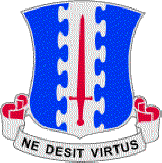 |
| ||||||||||
| U.S. Infantry Regiments | |
|---|---|
| Previous | Next |
| 186th Infantry Regiment | 188th Infantry Regiment |
The 187th Infantry Regiment (Rakkasans)[1] is a regiment of the 101st Airborne Division (Air Assault) of the United States Army. The nickname "Rakkasans" is derived from the Japanese word for parachute (literally "umbrella for falling"). The name was given to the 187th during its tour in occupied Japan following World War II. When a translator dealing with local Japanese dignitaries was trying to explain what their unit was trained to do (and not knowing the Japanese word for "airborne soldiers") he used the phrase "falling down umbrella men", or rakkasan. Amused by the clumsy word, the locals began to call the troopers by that nickname; it soon stuck and became a point of pride for the unit.
As of 2012, the 1st and 3rd Battalions are the only active elements of the regiment; they are assigned to the 3rd Brigade Combat Team, 101st Airborne Division.
World War II and aftermath
The regiment was originally constituted as the 187th Glider Infantry Regiment[2] on 12 November 1942, and activated on 25 February 1943 at Camp Mackall, North Carolina. It was originally a two battalion glider regiment assigned to the 11th Airborne Division, the men of the 187th trained both as glider and parachute troops. They moved to Camp Polk on 9 January 1944 for glider training. The regiment staged at Camp Stoneman, California on 29 April 1944, and departed from the San Francisco Port of Embarkation on 6 May 1944.
The regiment arrived in New Guinea on 29 May 1944 and joined the New Guinea Campaign. The regiment departed New Guinea on 11 November 1944, and arrived on Leyte on 18 November 1944 to join the Leyte Campaign.
The regiment left Leyte, and joined the Luzon Campaign by assaulting Nasugbu Point Luzon on 31 January 1945, blocking Japanese forces as part of the advance on Manila from the south. From then until April 1945, the 187th fought their way from Nichols Field, Fort William McKinley, and Manila to Mount Macolod and Malepunyo.
In May 1945, the 187th moved into Lipa to refit, rebuild, and prepare for Operation Downfall, the planned invasion of Japan. At this time, the 3rd Battalion was formed and the regiment was redesignated a para-glider regiment.
The regiment was attached to the Provost Marshal General, U.S. Army Forces Far East from 1 June 1945 through 27 July 1945 at Manila. The campaigns in the Philippines were declared completed on 4 July 1945, and the regiment moved to Okinawa on 12 August 1945 for occupation duty. This is where the unit gained its name; Rakkasan, when it was the only unit to parachute onto Japanese soil at the time. After the war ended on 14 August 1945, the regiment subsequently moved to Japan on 30 August 1945, and was alleged to be the first foreign ground combat unit to enter that nation.[3]:134
In April 1949, the regiment returned to the United States and was stationed at what was then Camp Campbell, Kentucky.[3]:140 It was redesignated the 187th Airborne Infantry Regiment on 30 June 1949 and became part of the 11th Airborne Division.[2] In early 1950, the 187th participated in "Operation Swarmer," the largest peacetime airborne maneuver in history.
Korean War
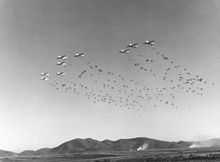
The 187th was selected as an airborne regimental combat team responding to the crisis in Korea. On 1 August 1950 the regiment became the 187th Airborne Regimental Combat Team (ARCT) when supporting units were added and deployed to Japan, arriving on 20 September 1950. The advance party of the Third Battalion of the Rakkasans was the first to arrive in Korea, arriving at Kimpo Airfield on 23 September. On 24 September, it was placed under the operational control of the First Marine Division, relieving the 2d Battalion of the 7th Marine Regiment, arriving almost a week after Douglas MacArthur's surprise landing at Inchon on 17 September 1950.
One month later, on 20 October 1950, the regiment made successful combat parachute assaults near the towns of Sukchon and Sunchon, North Korea as part of the Battle of Yongju. The published purpose of that drop was to capture members of the North Korean Government fleeing Pyongyang and also to free American POWs being moved from Pyongyang toward the Manchurian border. Neither objective was realized but were followed by battles at Suan, Wonju, Kaesong, Munsan-ni, and Inje.
The 187th led the second and last parachute assault in Korea on 23 March 1951(Operation Tomahawk).
Under BG Thomas J. H. Trapnell, it redeployed to Japan on 26 June 1951 where it became a strategic reserve but returned to Korea on 24 May 1952 to assist in the suppression of the prisoner rebellion at the Geoje POW Camp (aka. Koje Pow Camp during the Korean War) where prisoners had forcibly seized and held Brigadier General Francis Dodd, camp commandant, hostage for four days from May 7, 1952 (Koje Island Incident). After this, it once more returned to Japan on 18 October 1952 but made its final return to Korea on 22 June 1953. The unit returned to the United States in July 1955 and, the following year, became part of the newly reactivated 101st Airborne Division, Fort Campbell, KY.[2]
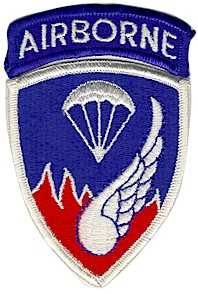
The 187th Airborne Regimental Combat Team consisted of the following units: The following units were assigned by General Order 34 (Confidential) Headquarters 11th Airborne Division.
- 187th Airborne Infantry Regiment
- 674th Airborne Field Artillery Battalion (105mm)
- Battery "A", 88th Airborne Antiaircraft Artillery Battalion
- Company "A", 127th Airborne Engineer Battalion
The following units were added on 23 August 1950 by General Order 41, 11th Airborne Division dated 22 August 1950.
- Detachment, 11th Airborne Military Police Company
- Detachment, 11th Airborne Quartermaster Company
- Parachute Maintenance Company
- Pathfinders from 11th Airborne Division
The following units were attached on 26 August 1950 per General Order 42, Headquarters 11th Airborne Division dated 25 August 1950.
- Platoon, Ambulance Company, 11th Airborne Medical Battalion
- Platoon, Clearing Company, 11th Airborne Medical Battalion
On 28 August 1950, Operations Order Number 1, IX Corps, the 2348th Quartermaster Air Packaging and Resupply Company was attached to the command of Colonel Bowen
- Attached units
- 2nd and 4th Ranger Infantry Companies (Airborne) (3 March 1951 – 4 April 1951)
- 5-man FECOM Tactical Liaison Office Team, 8177th Army Unit. (Tactical Intelligence)
Many personnel from the 511PIR in the 11th Airborne Division were transferred to the 187th ARCT to bring it up to full strength for overseas deployment.[4]
During the Korean War, three members of the regiment were awarded the Medal of Honor: Lester Hammond, Jr., Rodolfo P. Hernandez and Richard G. Wilson.
The 1950s and early 1960s were a turbulent time for 3rd Battalion, 187th Infantry. It returned to the US in 1955, this time to Fort Bragg, North Carolina.[3]:255 As part of a larger realignment of the Army, under the Pentomic Division concept, the Iron Rakkasans road marched to Fort Campbell in February 1956 to serve as the nucleus of the newly reactivated 101st Airborne Division.[3]:256–61
Post Korean War and air mobility
When the Pentomic concept that replaced regiments and battalions with battle groups was introduced in 1957, Companies A, B, and C of the 187th Airborne Infantry Regiment were redesignated as HHCs of the 1st, 2d, and 3d Airborne Battle Groups, 187th Infantry, respectively. The 1st ABG, 187th Infantry was assigned to the 11th Airborne Division in Germany from 1 March 1957 to 1 July 1958, when the 11th was inactivated and reflagged as the 24th Infantry Division. During its assignment to the 24th it was involved in the Lebanon intervention. On 8 February 1959 it was relieved from the 24th, rotated back to the United States and was assigned to the 82nd Airborne Division at Fort Bragg, NC. Its colors were inactivated on 25 May 1964 and concurrently consolidated with the 1st Battalion, 187th Infantry (constituted and activated 1 February 1964 at Fort Benning, Georgia, as an element of the 11th Air Assault Division, and the consolidated unit designated as the 1st Battalion, 187th Infantry, an element of the 11th Air Assault Division (Test) at Fort Benning, GA. It was inactivated on 30 June 1965 when the 11th Air Assault Division and 2nd Infantry Division were combined to form the 1st Cavalry Division (Airmobile), during which time the elements of both the 11th and 2nd were reflagged with new designations.
The 2nd ABG, 187th Infantry remained assigned to the 101st Airborne Division and was inactivated on 1 February 1964 when the Army abandoned the Pentomic structure in favor of brigades and battalions.
The 3rd ABG, 187th Infantry was not active during the Pentomic era. The colors were redesignated on 1 February 1963 as HHC, 3d Battalion, 187th Infantry, assigned to the 11th Air Assault Division (Test) at Fort Benning, GA, and activated on 7 February 1963.[3]:263 Over the next year, 3rd Battalion, 187th Infantry Regiment served as a test unit to help validate the Army’s airmobile concept. It was relieved from the 11th on 1 February 1964 and the colors were assigned to the 101st Airborne Division at Fort Campbell, KY. There was no transfer of troops or equipment; instead, the existing 3–187th at Fort Benning was reflagged as 1–187th.
Vietnam War
The Iron Rakkasans moved back to Fort Campbell, Kentucky in February 1964, to serve as part of the 3rd Brigade, 101st Airborne Division.[3]:266 In December 1967 the 3rd Battalion deployed to Vietnam, alongside 1st and 2nd Battalion, 506th Infantry Regiment.[3]:269–70 Over the next four years the Iron Rakkasans fought in twelve major campaigns, conducting numerous air assaults and search and destroy missions. During one such mission in March 1968 Captain Paul W. Bucha, commander of D Company, received the Medal of Honor when he crawled through a hail of fire to single-handedly destroy a machine gun bunker with grenades near Phuoc Vinh, Vietnam.[3]:270 When the battalion colors returned to Fort Campbell the unit had distinguished itself by earning two Valorous Unit Awards, and its third and fourth Presidential Unit Citations for the battles of Trang Bang and Dong Ap Bia Mountain (commonly known as “Hamburger Hill”).[3]:282–301 The Iron Rakkasans emerged from the Vietnam War as the country’s most highly decorated airborne battalion.
Assignments in South Vietnam[5]
| Administrative Headquarters |
Forward Headquarters |
Arrival | Major Command |
|---|---|---|---|
| 3/187th Infantry Regiment arrived in Vietnam on 1967-12-16 | |||
| Phước Vĩnh | Phuoc Vinh | December 1967 | 3/101 Airborne Division |
| Đắk Tô | June 1968 | ||
| Củ Chi | July 1968 | ||
| Long Binh | October 1968 | 3/101 Airborne Division (Airmobile) | |
| Bien Hoa | Phong Dien District, Can Tho | November 1968 | |
| Ta Bat | July 1969 | ||
| A Shau Valley | Firebase Berchtesgaden | August 1969 | |
| Bien Hoa | Ta Bat | September 1969 | |
| Phong Dien | October 1969 | ||
| Mai Loc | November 1969 | ||
| Phong Dien | Phong Dien | December 1969 | |
| Huế | Phu Bai | September 1970 | |
| Camp Carroll | Camp Carroll | March 1971 | |
| April 1971 | 1/5th Infantry Division (Mechanized) | ||
| Huế | Phu Bai | May 1971 | 3/101st Airborne Division (Airmobile) |
| August 1971 | US Army Forces, Military Region 2 | ||
| November 1971 | 3/101st Airborne Division (Airmobile) | ||
| 3/187th Infantry Regiment departed Vietnam on 1971-12-10 | |||
The 3/187th Infantry's exploits from 10–20 May 1969 on hill 937 in the A Shau Valley were depicted in a 1987 movie using the hill's nickname Hamburger Hill as the title. For this action the unit received the Presidential Unit Citation.
Post Vietnam
When the 101st returned from Viet Nam, most of its personnel in the rank of staff sergeant and below were discharged upon arrival at Oakland, California, or Seattle, Washington. What remained largely consisted of a command group of staff officers and senior NCOs. The division settled into buildings recently vacated by the "U.S. Army Training Center, Fort Campbell, Kentucky."
When the 101st was rebuilt, the separate 173rd Airborne Brigade was inactivated and its assets used to form the 3rd Brigade as an airborne unit consisting of 1–503rd INF, 2–503rd INF, and 3–187th INF. The partial airborne capability also extended to supporting units of the division (i.e., one company of three in a supporting unit was airborne). This lasted only until April 1974, when jump status for the 3rd Brigade was terminated, and the Airmobile Badge (renamed Air Assault Badge later that year) was introduced.
In October 1983 the 1st, 2d, and 4th Battalions, 187th Infantry, were activated, and on 21 November 1984 a 5th Battalion was activated. The 1st and 2nd Battalions were assigned to the 193rd Infantry Brigade in Panama and the 3rd, 4th and 5th were assigned to the 101st Airborne Division (Air Assault) at Fort Campbell. The 4th and 5th were created by reflagging the existing 1–503rd and 2–503rd, the colors of which were soon reactivated in Korea within the 2nd Infantry Division. The Panama-based 2–187th included one airborne company (Moatengators) within the battalion, and later jump status was expanded to the entire battalion. 2/187th was the last airborne battalion of the 187th. During a realignment of the United States Army's combat forces in 1987 the 1st and 2d Battalions were inactivated and the 5th and 4th Battalions were reflagged as the 1st and 2d Battalions, respectively. Upon moving to the 101st, the 187th became air assault.
From September 1988 through March 1989, 1st Battalion reorganized as Task Force 1–187 and deployed to the Sinai Desert, Egypt as the United States' contingent of the Multinational Force and Observers peacekeeping mission.
Gulf War
In September 1990 the Rakkasans were deployed to Saudi Arabia during Operation Desert Shield. In February 1991 two companies from the 1st Battalion captured 434 Iraqi soldiers during the air assault into Objective Weber and on 25 February the Rakkasans conducted the deepest and largest air assault operation in history. Striking 155 miles (249 km) behind enemy lines into the Euphrates river valley, the assault led to the timely defeat of Iraqi forces and contributed to a total allied victory. The unit moved farther north than any other unit during Operation Desert Storm.
Between Gulf War and GWOT
From 1991 to 1993 the 3/187 was commanded by Lt. Colonel David H. Petraeus who renamed the battalion the Iron Rakkasans after the physical training test he created. CSM Donald Purdy was the Battalion Sergeant Major during this time.
In 1995 The Iron Rakkasans was redesignated as Task Force 3–187 and deployed to the Sinai Peninsula in July 1995. The Iron Rakassans were responsible for the southern portion of Zone C and based at South Camp, Sharm el Shiek, Egypt. During the deployment, they were instrumental in the recovery of casualties from an accident near one of the sector control centers and evacuating them to hospitals utilizing Multinational Forces Helicopters. On 23 November 1995, a 7.1 earthquake hit the Sinai Peninsula. Again the Iron Rakkasans performed road recon and rescue operations throughout the peninsula. The Iron Rakkasans earned a Army Superior Unit Award for their actions during the deployment. The unit returned to the United States in January 1996.
In September 1996 through January 1997 elements of Raider Rakkasan, Alpha "Blackhawks" Company, 2nd Battalion, 187th Infantry deployed to Saudi Arabia in support of Operation Desert Focus, providing force protection for U.S. personnel in support of US air assets in Saudi Arabia relocated from Dhahran and from Riyadh to the remote Prince Sultan Air Base, Camp Eagle Town II. The move's purpose was force protection, and came in the wake of the 25 June 1996 terrorist bombing at Khobar Towers which killed 19 airmen and wounded many more. U.S. and Saudi Arabian officials agreed to split the $200 million cost of relocating more than 4,000 US troops. Charlie Company, 2nd Battalion was awarded the Armed Forces Expeditionary Medal and the Army Superior Unit Award.[6]
In February 2000 through August of 2000 1/187 deployed to Kosovo for peacekeeping operations as apart of Task Force Falcon in support of Operation Joint Guardian.
Afghanistan and Iraq
In 2001-2002, following the attacks of 9-11, the Rakkasans deployed to Afghanistan in support of Operation Enduring Freedom where they most notably participated in Operation Anaconda in the eastern Shah-i-Khot region. The 2nd Battalion (Raider Rakkasans) as well as B,C, and D company 1st Battalion (Leader Rakkasan) were awarded the Valorous Unit Award for combat valor during this period.
In 2003, the Rakkasans, commanded by Colonel Mike Linnington, were deployed for the 2003 invasion of Iraq. The 3rd Battalion, 187th Infantry was temporarily attached to the 3rd Infantry Division and accompanied them during the push into Baghdad. While attached to the 3rd Infantry Division, 3rd Battalion cleared the Republican Guard headquarters and Baghdad International Airport in April 2003. For this action the battalion earned an unprecedented fifth Presidential Unit Citation. Following the invasion 3rd Battalion conducted six months of security operations near Rabia, Iraq, on the Syrian border, to block the flow of foreign fighters. Prior to returning stateside in January 2004 the Iron Rakkasans conducted combat operations in Husaybah, Iraq with the 3d Armored Cavalry Regiment. Once back in the US the battalion added a forward support company.
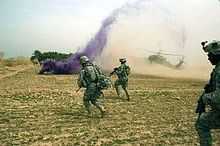
Before moving north to Ninawa Governorate (province), the Rakkasans conducted extensive stability and support operations in Baghdad's southeast sector. The Rakkasans conducted the majority of their operations in the northwest of Ninevah province with the 1st Battalion, 187th Infantry focusing efforts around Tallafar, Zumar, and Avgani. The 2nd Battalion, 187th Infantry worked primarily around Sinjar and Biaj, and the 3rd Battalion was headquartered in Rabia.
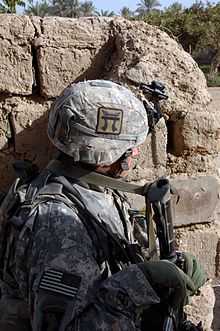
They returned to Fort Campbell in 2004 and redeployed to Iraq again in the fall of 2005. During their second tour in Iraq, they focused operations in Salah ad Din province, with the 3rd Battalion, The brigade commander was Colonel Michael D. Steele. During this deployment that the brigade conducted "Operation Swarmer", one of the largest combat operations in Iraq since the initial invasion. Rakkasans worked with Iraqi Army soldiers throughout Salah ad Din province defeating insurgents, Al Qaeda cells, and uncovering numerous caches of weapons and explosives.[7]
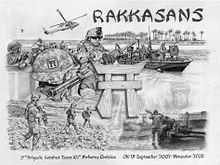
In October 2007 the Rakkasans again deployed to Iraq in support of Operation Iraqi Freedom 07-09 led by brigade commander Col. Dominic Caraccilo. The brigade was headquartered at Camp Striker near Baghdad with an area of operation that extended from the Euphrates river in the west to the Tigris in the east and ran south from Baghdad to Al-Mahmudiyah. This area included the Triangle of Death which had seen significant violence in the war and was often a staging area for the insurgency. As a unit following the surge, the Rakkasans manned combat outposts throughout the rural areas to provide local security for the populace, partner with Iraqi defense and police forces, and facilitate numerous economic and developmental projects. When the Rakkasans redeployed to Fort Campbell at the end of their tour in November 2008, they did not transfer authority to an incoming U.S. military unit. Instead, the area became the responsibility of the partnered Iraqi forces marking a significant step in the transference of security and authority from coalition forces to the Iraqis.[8][9]
In January 2010, the Rakkasans again deployed to Regional Command East in Afghanistan for a 12 month deployment. In September of 2012, the Rakkasans performed the last Brigade sized combat deployment.
Heraldry, lineage, and honors
Coat of arms
- Shield: Azure on a pale nebuly Argent a double handed sword erect Gules.
- Crest: On a wreath Argent and Azure between a Japanese city symbol Gules and a mullet of seven points per fess wavy of the last and of the second, a sea lion Or charged on the shoulder with a heart Purpure and holding in his dexter paw a sword bendwise of the first with hilt and pommel of the fourth the blade notched three times to base of the third.
- Motto: NE DESIT VIRTUS (Let Valor Not Fail).
The symbolism includes: Slang term : Angels From Hell, For retired insignia.
- Shield:
- Blue is for the Infantry.
- The partition line of the pale heraldically representing clouds and the doubled-handed sword, an ancient infantry weapon, symbolizes the character of the organization as an Airborne Infantry unit.
- Crest: The golden seal lion, adapted from the seal of the President of the Philippines, represents the award of the Philippine Presidential Unit Streamer for the campaign on Manarawat, scene of the first combat jump of the 187th.
- The heart on the lion's shoulder points out the action on Purple Heart Hill.
- The winged sword with three notches in the blade signifies the unit's score of three combat jumps, one in the Philippines and two in Korea.
- The red diamond shape is the insignia of the city of Yokohama, Japan, where the 187th landed as the first American combat troops and began four years of occupation duty.
- The seven-pointed star, divided in the manner of the Korean Taeguk stands for the unit's seven campaigns in that country.
The coat of arms was originally approved on 1952-12-15 for the 187th Airborne Infantry Regiment. It was redesignated for the 187th Infantry Regiment on 1958-02-07.
Lineage
- Regiment Constituted 12 November 1942 in the Army of the United States as the 187th Glider Infantry Regiment.
- Assigned 25 February 1943 to the 11th Airborne Division and activated at Camp Mackall, North Carolina.
- Allotted 15 November 1948 to the Regular Army.
- Reorganized and redesignated 30 June 1949 as the 187th Airborne Infantry Regiment
- Reorganised as the 187th Airborne Regimental Combat Team on 1 Aug 1950 and posted to Japan where it served in the Korean War[10]
- Relieved 1 February 1951 from assignment to the 11th Airborne Division.
- Regiment Assigned 1 July 1956 to the 101st Airborne Division.
- 1st Battalion Reorganized and redesignated 1 March 1957 as Headquarters and Headquarters Company, 1st Airborne Battle Group, 187th Infantry, relieved from assignment to the 101st Airborne Division, and assigned to the 11th Airborne Division (organic elements concurrently constituted and activated).
- On 25 April 1957, the following actions took place:
- Regimental Headquarters Relieved from assignment to the 101st Airborne Division; concurrently reorganized and redesignated as the 187th Infantry Regiment, a parent regiment under the Combat Arms Regimental System.
- 2nd Battalion Reorganized and redesignated Headquarters and Headquarters Company, 2nd Airborne Battle Group, 187th Infantry, and remained assigned to the 101st Airborne Division (organic elements concurrently constituted and activated)
- 3rd Battalion Inactivated at Fort Campbell, Kentucky, and relieved from assignment to the 101st Airborne Division; concurrently redesignated as Headquarters and Headquarters Company, 3rd Airborne Battle Group, 187th Infantry
- 1st Battle Group Relieved 1958-07-01 from assignment to the 11th Airborne Division and assigned to the 24th Infantry Division.
- 1st Battle Group Relieved 1959-02-08 from assignment to the 24th Infantry Division, and assigned to the 82d Airborne Division.
- 3rd Airborne Battle Group Redesignated 1963-02-01 as Headquarters and Headquarters Company, 3d Battalion, 187th Infantry Regiment, and assigned to the 11th Air Assault Division (organic elements concurrently constituted)
- 3rd Battalion activated 7 February 1963 at Fort Benning, Georgia.
- The following actions took place on 1 February 1964:
- 1st Battalion, 187th Infantry Regiment constituted and activated at Fort Benning, Georgia, as an element of the 11th Air Assault Division.
- 2nd Battle Group relieved from assignment to the 101st Airborne Division
- 3rd Battalion Relieved from assignment to the 11th Air Assault Division and assigned to the 101st Airborne Division
- 2nd Battle Group Inactivated 3 February 1964 at Fort Campbell, Kentucky.
- 1st Battle Group Inactivated 25 May 1964 at Fort Bragg, North Carolina; concurrently consolidated with the 1st Battalion, 187th Infantry, and consolidated unit designated as the 1st Battalion, 187th Infantry, an element of the 11th Air Assault Division (later redesignated as the 11th Airborne Division)
- On 1 October 1983, the following actions took place:
- 187th Infantry Regiment Regiment Withdrawn from the Combat Arms Regimental System and reorganized under the United States Army Regimental System
- 1st Battalion Relieved from assignment to the 11th Airborne Division, assigned to the 193rd Infantry Brigade, and activated in Panama.
- 2nd Battle Group Redesignated as the 2d Battalion, 187th Infantry, assigned to the 193rd Infantry Brigade, and activated in Panama
- 1st Battalion Inactivated 1 May 1987 in Panama and relieved from assignment to the 193d Infantry Brigade.
- 2nd Battalion Inactivated 10 July 1987 in Panama and relieved from assignment to the 193d Infantry Brigade.
- On 1987-09-16, the following actions took place:
- 1st Battalion activated at Fort Campbell, Kentucky and assigned to 101st Airborne Division.
- 2nd Battalion activated at Fort Campbell, Kentucky and assigned to 101st Airborne Division.
- On 2004-09-16, 1st Battalion and 3rd Battalion were relieved from assignment to the 101st Airborne Division and assigned to the 3d Brigade Combat Team, 101st Airborne Division [11][12]
- On 2005-10-01, the following actions took place:
- 1st Battalion, 187th Infantry redesignated as the 1st Battalion, 187th Infantry Regiment
- 3rd Battalion, 187th Infantry redesignated as the 3rd Battalion, 187th Infantry Regiment
Campaign participation credit
- World War II:
- New Guinea;
- Leyte;
- Luzon (with arrowhead)
- UN Offensive (with arrowhead);
- CCF Intervention;
- First UN Counteroffensive (with arrowhead);
- CCF Spring Offensive;
- Korea, Summer-Fall 1952;
- Korea, Summer 1953
- Counteroffensive, Phase III;
- Tet Counteroffensive;
- Counteroffensive, Phase IV;
- Counteroffensive, Phase V;
- Counteroffensive, Phase VI;
- Tet 69/Counteroffensive;
- Summer-Fall 1969;
- Winter-Spring 1970;
- Sanctuary Counteroffensive;
- Counteroffensive, Phase VII;
- Consolidation I;
- Consolidation II
- Defense of Saudi Arabia;
- Liberation and Defense of Kuwait
Decorations
- TAGAYTAY RIDGE
- SUKCHON
- TRANG BANG
- DONG AP BIA MOUNTAIN
- OIF 1
- INCHON
- Valorous Unit Award for:
- BINH DUONG PROVINCE
- THUA THIEN PROVINCE
- OPERATION ANACONDA (OEF 1)
- GHAZNI, PAKTYA, PAKTIKA, AND KHOWST PROVINCE (OEF 4)
- VIETNAM 1968
- SOUTHWEST ASIA
- Army Superior Unit Award for 1995–1996
- Philippine Presidential Unit Citation for 1944-10-17 TO 1945-07-04.
- KOREA 1950–1952
- KOREA 1952–1953
Notable Rakkasans
- GEN William Westmoreland (Commanded the Rakkasans in part of the Korean War)
- GEN David Petraeus
- GEN Melvin Zais
- GEN Norman Schwarzkopf, Jr.
- LTG Francis Wiercinski
- LTG Joseph Kinzer
- MG Frank S. Bowen (Commanded for part of the Korean War-3 combat jumps, 2x DSC)
- COL Michael D. Steele
- CPT Paul W. Bucha, Medal of Honor (Vietnam)
- CPT Andrew T. McGuire (Korea), received two Silver Stars, three Bronze Stars (all with V device) and three Purple Hearts (all for GSW). Made both combat jumps in Korea with 187th.
- SMA George W. Dunaway (Second Sergeant Major of the Army, was CSM of Rakkasans from 1954–1960)
- CSM Basil L. Plumley (Served with and made a combat jump in Korean War) CSM in "We were Soldiers Once and Young"
- SGM Eric J Geressy (Iraq) Silver Star, three Bronze Stars, and the Army Commendation Medal for Valor [13]
- CPL Ray B. Gonzalez, received a Distinguished Service Cross and Silver Star on the same day for valor in Korea
- CPL Lester Hammond, Jr., Medal of Honor (Korea)
- CPL Rodolfo P. Hernandez, Medal of Honor (Korea)
- SPC Ryan A. Conklin, reality TV star and author of An Angel From Hell which chronicled A Co. 3/187th Infantry during the Iraq deployment of 2005-2006.
- PFC Richard G. Wilson, Medal of Honor (Korea)
- PFC Stephen Flemmi, Silver Star (Korea), later became Winter Hill Gang member, FBI Top Echelon Program Informant and convicted murderer
In film
The "Rakkasans" are portrayed in the 1987 movie Hamburger Hill.
The 187th AIR was also portrayed in the 2003 movie Big Fish. Ewan McGregor's character returns home from the Korean War wearing the 187 Airborne Infantry Regiment patch
See also
- 3rd Battalion, 187th Infantry Regiment (United States)
- 3rd Special Troops Battalion, 3rd Brigade Combat Team, 101st Airborne Division (Air Assault)
References
![]() This article incorporates public domain material from the United States Army Center of Military History document "187th Infantry Lineage and Honors".
This article incorporates public domain material from the United States Army Center of Military History document "187th Infantry Lineage and Honors".
- ↑ 1.0 1.1 "Special Unit Designations". United States Army Center of Military History. 21 April 2010. Archived from the original on 9 June 2010. Retrieved 23 June 2010.
- ↑ 2.0 2.1 2.2 187th Airborne
- ↑ 3.0 3.1 3.2 3.3 3.4 3.5 3.6 3.7 3.8 Flanagan, E. M. (1997). The Rakkasans: The Combat History of the 187th Airborne Infantry. Random House Publishing Group. ISBN 978-0-89141-604-3. Retrieved 28 June 2013.
- ↑ History of the 511th Airborne Regiment, The Drop Zone
- ↑ Stanton, Shelby (1981). Vietnam Order Of Battle. New York, New York: Galahad Books. pp. 396 w/Index. ISBN 0-88365-709-0.
- ↑ http://www.globalsecurity.org/military/ops/desert_focus.htm
- ↑ DefenseLINK press release
- ↑ Hardy, Kerensa (August 14, 2008). "17th IA MiTT helps Iraqi partners with transition". Fort Campbell Courier.
- ↑ Hardy, Kerensa (August 7, 2008). "Rakkasans: South Baghdad ready for transition". Fort Campbell Courier.
- ↑ http://www.korean-war.com/187airborne.html
- ↑ http://www.history.army.mil/html/forcestruc/lineages/branches/inf/0187in003bn.htm
- ↑ http://www.history.army.mil/html/forcestruc/lineages/branches/inf/0187in001bn.htm
- ↑ http://projects.militarytimes.com/citations-medals-awards/recipient.php?recipientid=3837
External links
| Wikimedia Commons has media related to 187th Infantry Regiment (United States). |
